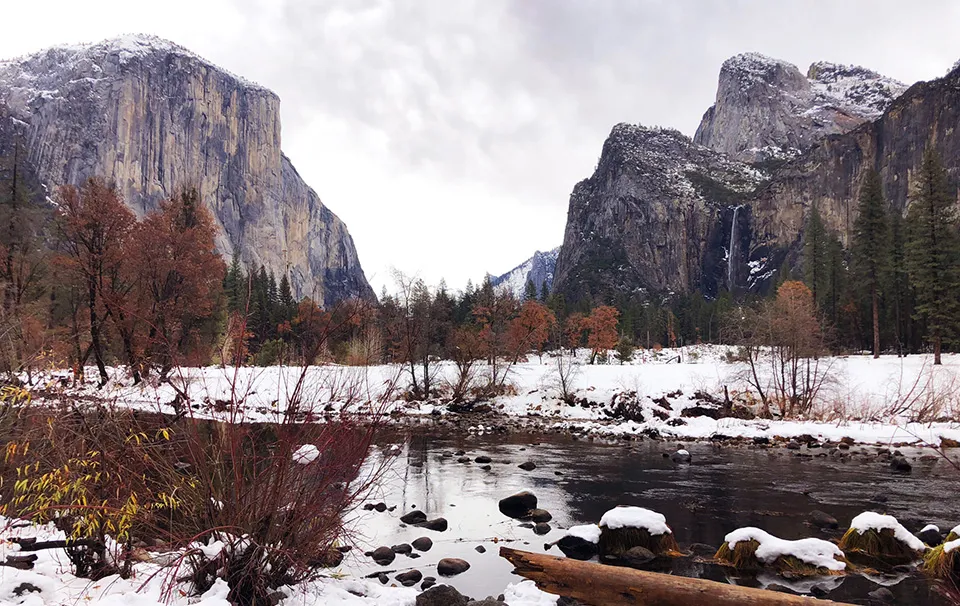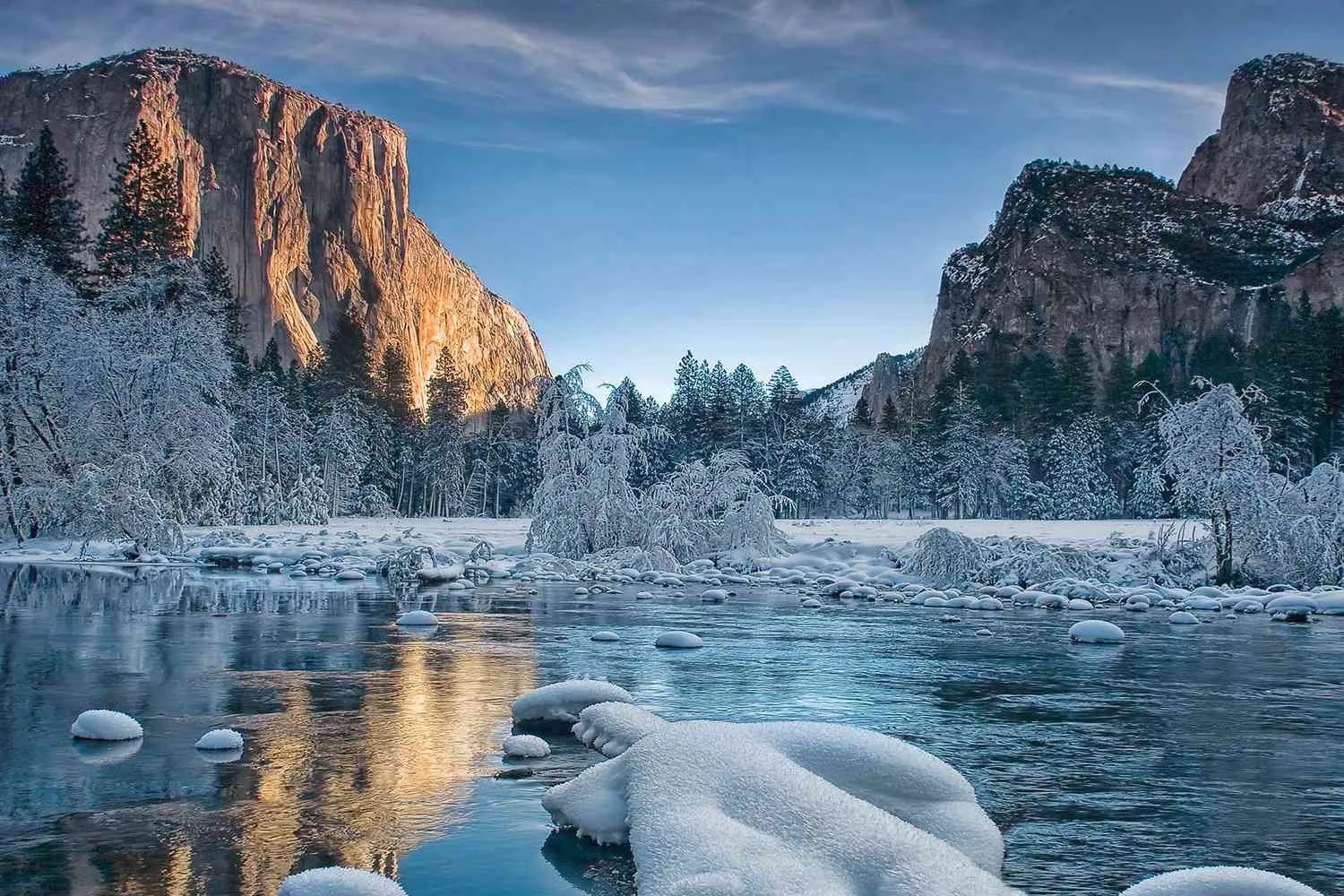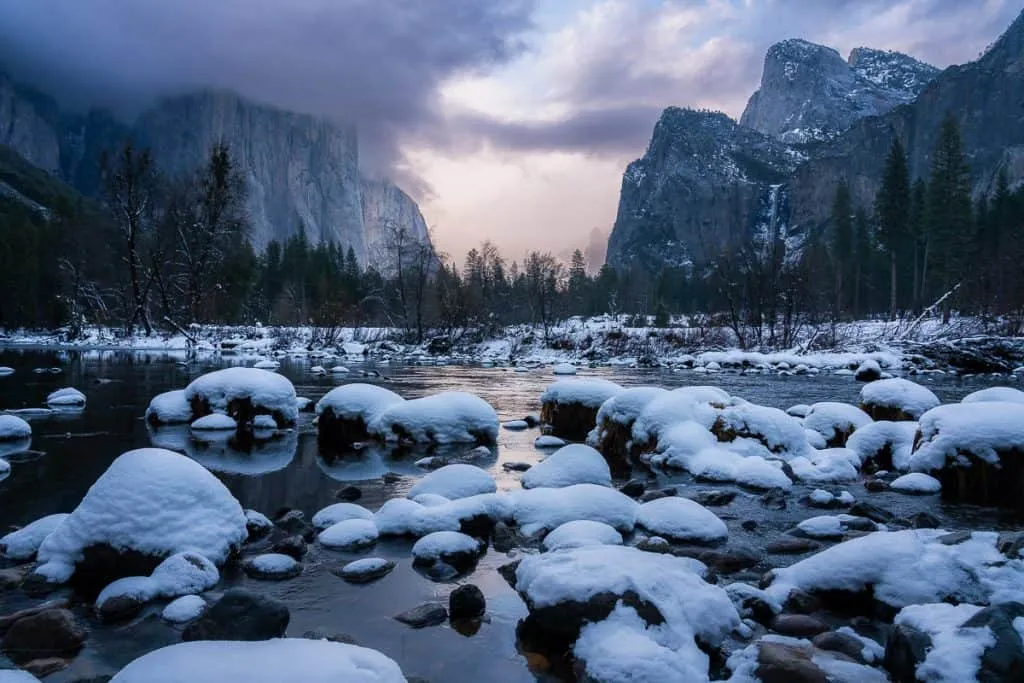.webp)
Your Complete Guide to Yosemite National Park Winter: Adventures, Photography, and Insider Tips for 2025
Discover the magical winter wonderland of Yosemite National Park through my personal experiences and expert insights. From snow-covered granite peaks to intimate wildlife encounters, I'll guide you through everything you need to know for an unforgettable Yosemite national park winter adventure, including the best activities, photography spots, and practical planning tips that most visitors never discover.
The Magic of Yosemite National Park Winter

I've been visiting Yosemite national park winter for over fifteen years, and I can confidently say there's nothing quite like experiencing this iconic landscape transformed by snow and ice. When most tourists flee to warmer destinations, those of us who venture into Yosemite's winter wonderland are rewarded with an entirely different park – one that's quieter, more intimate, and breathtakingly beautiful in ways that summer visitors never experience.
During my first winter visit in 2009, I was struck by the profound silence that blankets the valley after a fresh snowfall. The usual crowds disappear, leaving you with unobstructed views of Half Dome draped in white, El Capitan's granite face contrasting dramatically against snow-laden trees, and Yosemite Falls often frozen into spectacular ice formations. This transformation creates photography opportunities and peaceful moments that simply don't exist during peak season.
The advantages of visiting Yosemite national park winter extend far beyond fewer crowds. Winter brings unique activities impossible during warmer months: world-class skiing at Badger Pass (California's oldest ski area), snowshoeing through pristine sequoia groves, ice skating beneath Half Dome at Curry Village, and cross-country skiing along Glacier Point Road. The famous Horsetail Fall "firefall" phenomenon occurs exclusively in February, when sunset light creates the illusion of flowing lava down El Capitan's eastern face.
However, I must be honest about the challenges. Winter weather can be unpredictable and harsh, with temperatures dropping below freezing and sudden storms that can close roads and trails. Proper preparation is essential – I've learned this through experience, including one memorable trip where inadequate gear nearly cut short my adventure. The reward for proper planning, however, is access to one of North America's most spectacular winter landscapes, where every sunrise brings new possibilities for discovery and every sunset paints the granite walls in colors you'll never forget.
Book Your Winter Yosemite AdventureWeather Conditions and Best Times to Visit
Understanding Yosemite national park winter weather patterns is crucial for planning a successful trip. Through my years of winter visits, I've experienced everything from balmy 60°F days with brilliant sunshine to bitter cold snaps with temperatures plummeting to 15°F and winds that make exposed skin sting within minutes. This variability is both the challenge and the beauty of winter in the Sierra Nevada.
Yosemite Valley sits at 4,000 feet elevation, where winter temperatures typically range from highs in the mid-40s to mid-50s and lows in the high 20s to mid-30s. However, elevation changes dramatically affect conditions – Badger Pass at 7,200 feet averages 5-10°F cooler, while areas above 8,000 feet can be 20-30°F colder than the valley floor. I've experienced snow in the valley while rain fell in the foothills, demonstrating how quickly conditions change with elevation.

December through March represents peak winter season, when Tioga Road and most of Glacier Point Road close due to snow accumulation. January and February typically offer the most reliable snow conditions for winter sports, though I've encountered significant snowfall as early as November and as late as April. The most magical experiences often occur during or immediately after winter storms, when fresh snow transforms familiar landmarks into an entirely new landscape.
For photography enthusiasts seeking the famous Horsetail Fall firefall, mid to late February provides the best opportunities. This phenomenon requires specific conditions: sufficient snowmelt to create the waterfall, clear western skies for sunset light, and proper viewing angles. During my twelve attempts to photograph this event, I've succeeded only four times, emphasizing the importance of flexibility and patience when planning around natural phenomena in Yosemite national park winter.
My recommendation for first-time winter visitors is to plan trips between mid-December and early March, allowing flexibility for weather delays. Always check current conditions through the National Park Service website and road condition hotline (209-372-0200) before departure. Weather can change rapidly in the mountains – I've witnessed sunny morning conditions deteriorate into whiteout blizzards within hours, making real-time information essential for safe travel.
Essential Winter Activities and Adventures
Valley Floor Adventures
Yosemite Valley remains accessible throughout winter, offering numerous activities that showcase the park's winter beauty. My favorite valley floor experience is the early morning walk around Cook's Meadow, where frost-covered grasses create a magical foreground for Half Dome photography. The 1-mile Lower Yosemite Falls trail provides easy access to spectacular ice formations, though I recommend bringing microspikes for icy sections near the falls' base.
The Valley Loop Trail offers 7.2 miles of relatively flat hiking with constantly changing perspectives of iconic landmarks. During winter, this trail becomes a peaceful sanctuary where wildlife viewing opportunities increase dramatically. I've encountered coyotes hunting in meadows, observed great horned owls during evening walks, and watched black bears foraging near the Merced River – experiences that rarely occur during busy summer months when human activity keeps wildlife hidden.
Winter Sports at Badger Pass
Badger Pass Ski Area represents the heart of Yosemite national park winter recreation. As California's oldest downhill ski area (established 1933), Badger Pass offers family-friendly slopes perfect for beginners and intermediate skiers. The ski area typically operates from mid-December through late March, weather permitting. What makes Badger Pass special isn't just its history – it's the surreal experience of skiing while surrounded by Yosemite's granite monuments.
Cross-country skiing and snowshoeing from Badger Pass provide access to otherwise unreachable winter wilderness. The groomed track along Glacier Point Road offers gentle skiing for beginners, while advanced adventurers can attempt the challenging route to Glacier Point itself – a 10.5-mile round trip with 1,000 feet of elevation gain. My most memorable winter experience was snowshoeing to Dewey Point, where panoramic views of Yosemite Valley spread below like a snow-covered diorama.
Unique Winter Experiences
Ice skating at Curry Village creates magical memories beneath Half Dome's towering presence. This outdoor rink, operating from mid-November to mid-March, continues a tradition dating back to 1929. The combination of crisp mountain air, spectacular scenery, and the simple joy of gliding across ice makes this activity special for visitors of all ages. I particularly enjoy evening skating sessions, when floodlights illuminate the rink and stars begin appearing in the clear mountain sky.

Snowshoeing to Mariposa Grove provides intimate encounters with giant sequoias draped in snow. The 2-mile hike from the parking area to the grove entrance becomes a peaceful winter journey through mixed forest. These ancient trees, some over 2,000 years old, appear even more majestic when snow emphasizes their massive scale. The quiet of winter allows you to truly appreciate these giants without summer's constant stream of tour groups and shuttles.
Reserve Winter Activity GearWinter Photography and Firefall Phenomenon
Photographing Yosemite national park winter presents unique challenges and extraordinary opportunities. Winter's dramatic lighting conditions, snow-covered landscapes, and frequent weather changes create dynamic compositions impossible during other seasons. Through countless winter photography sessions, I've learned that success requires technical preparation, patience, and flexibility to adapt to rapidly changing conditions.
The famous Horsetail Fall firefall represents Yosemite's most sought-after winter photography opportunity. This phenomenon occurs when sunset light illuminates Horsetail Fall on El Capitan's eastern face, creating the illusion of flowing fire. Optimal viewing occurs during mid to late February, typically between February 12-28, when sun angles align perfectly with the waterfall. However, the firefall requires three critical conditions: sufficient snowmelt to create the waterfall, clear western skies for sunset light, and proper positioning for unobstructed views.
My successful firefall photographs required extensive preparation and multiple attempts. The best viewing locations include the El Capitan Picnic Area and various spots along Northside Drive, though crowds can be substantial during peak firefall season. I recommend arriving 2-3 hours before sunset to secure prime positioning and test different compositions. Remember that 2025 requires advance reservations for February weekend visits due to firefall popularity – plan accordingly to avoid disappointment.
Beyond the firefall, winter photography in Yosemite national park offers countless opportunities. Snow-covered Tunnel View provides classic compositions with Bridalveil Fall often frozen into spectacular ice formations. Valley View creates intimate scenes of snow-dusted granite and ice-fringed Merced River. Cathedral Rocks and Spires appear more dramatic against winter storm clouds, while fresh snow on Half Dome creates compositions that emphasize the monument's geometric perfection.
Technical considerations for winter photography include protecting equipment from moisture and extreme cold, carrying extra batteries (cold drains power quickly), and using polarizing filters to manage reflected light from snow. I always pack lens cloths to clear condensation, plastic bags to protect cameras during sudden weather changes, and backup memory cards. The reward for proper preparation is access to some of North America's most dramatic winter landscapes, where every storm brings new photographic possibilities and every sunrise reveals fresh perspectives on familiar landmarks.
Planning and Preparation Essentials
Transportation and Road Conditions
Driving to Yosemite national park winter requires careful preparation and understanding of mountain driving conditions. Snow chains or cables are mandatory when conditions warrant, regardless of vehicle type – including 4WD and AWD vehicles. I always carry chains from November through March, even for short day trips, as conditions can change rapidly. The park enforces three chain control levels: R1 (snow tires acceptable, carry chains), R2 (4WD/AWD with snow tires, carry chains), and R3 (chains required on drive wheels, no exceptions).
Highway 140 through Arch Rock entrance offers the most reliable winter access, maintaining the lowest elevation approach to Yosemite Valley. Highway 120 (Big Oak Flat entrance) and Highway 41 (Wawona entrance) involve steeper grades and higher elevations, increasing chain control likelihood. Inside the park, Tioga Road closes completely from approximately November through May, while Glacier Point Road closes beyond Badger Pass. Always check current conditions via the park's road condition hotline (209-372-0200) before departure.
Essential Winter Gear and Clothing
Proper clothing for Yosemite national park winter follows layering principles that accommodate dramatic temperature variations. Base layers should be moisture-wicking merino wool or synthetic materials – never cotton, which retains moisture and loses insulating properties when wet. Mid-layers include fleece or down insulation, while outer shells must be waterproof and breathable to handle everything from light snow to driving rain.
.webp)
Footwear represents the most critical gear decision for winter visits. Waterproof hiking boots with aggressive tread provide essential traction on icy trails, while microspikes or crampons offer additional security for serious winter hiking. I recommend wool or synthetic socks (never cotton) and always pack extra pairs. Hand and head warmth requires insulated, waterproof gloves and warm hats that cover ears. Sunglasses and sunscreen remain essential – snow reflection intensifies UV exposure, making sunburn possible even on overcast days.
Safety Considerations and Emergency Preparedness
Winter safety in Yosemite national park requires understanding mountain weather patterns and maintaining emergency supplies. I always carry a emergency kit including extra food, water, warm clothing, first aid supplies, flashlight, and emergency shelter. Cell phone coverage remains spotty throughout the park, making self-reliance essential. Weather conditions can deteriorate rapidly – I've experienced morning sunshine transform into afternoon blizzards with visibility dropping to mere feet.
Trail conditions change constantly during winter, with ice forming overnight even on previously clear paths. The Mist Trail often closes due to dangerous ice conditions, while Upper Yosemite Falls trail becomes a serious mountaineering route requiring winter climbing experience. I recommend informing others of your planned activities and expected return times, particularly for backcountry adventures. The park's winter rescue statistics emphasize that many emergencies result from inadequate preparation rather than unavoidable accidents.
Accommodation and Dining Options
Winter accommodation in Yosemite national park offers fewer options but often better availability and lower prices than peak season. Staying inside the park provides significant advantages during winter: proximity to activities, no daily driving on potentially hazardous roads, and easy access to ranger programs and spontaneous photography opportunities. My preferred winter lodging is Yosemite Valley Lodge, centrally located with excellent restaurant options and heated rooms that provide welcome refuge after cold outdoor adventures.
Curry Village offers budget-friendly options, though I recommend avoiding unheated tent cabins during winter unless you're equipped for sub-freezing sleeping conditions. The heated cabins and hotel rooms provide comfortable accommodation at reasonable rates. Ahwahnee Hotel (currently The Majestic Yosemite Hotel) represents luxury accommodation with elegant dining and historical ambiance, though winter rates remain high despite reduced services.
Winter camping requires serious preparation and appropriate gear. Upper Pines Campground remains open year-round, offering sites suitable for RVs and tent camping. However, winter camping means dealing with frozen water lines, challenging food storage in bear boxes, and potential equipment failure in extreme cold. I've successfully winter camped in Yosemite, but only recommend this option for experienced campers with proper cold-weather gear and realistic expectations about comfort levels.
Dining options become limited during Yosemite national park winter, with many summer facilities closing or reducing hours. The Mountain Room Restaurant at Yosemite Valley Lodge provides excellent meals with spectacular valley views, while the Iron Door Saloon offers casual dining in historic surroundings. The Village Store remains open year-round for groceries and supplies, though selection may be reduced during severe weather. I always pack emergency food supplies, as restaurant closures can occur during major storms.
Outside the park, gateway communities like Mariposa, Oakhurst, and Groveland offer additional accommodation options, though winter driving conditions make daily commutes challenging. These towns provide restaurants, grocery stores, and gear rental options that complement park facilities. However, I strongly recommend staying inside the park when possible to maximize your winter experience and minimize weather-related travel risks.
Dining reservations become crucial during peak winter periods, particularly around holidays and firefall season. Many visitors underestimate how quickly restaurants fill during limited winter operations. I recommend making dinner reservations immediately upon arrival, especially for weekend visits. The reduced dining options create opportunities to meet fellow winter adventurers and share stories about the day's discoveries – one of winter's unexpected social benefits in typically crowded Yosemite.
Conclusion
After two decades of exploring Yosemite national park winter, I can confidently say that winter visits offer some of the park's most rewarding experiences. The transformation of familiar landmarks into a snow-covered wonderland, the intimacy of smaller crowds, and the unique activities available only during winter months create memories that last a lifetime. From witnessing the magical firefall phenomenon to skiing beneath towering granite walls, winter Yosemite reveals aspects of this natural wonder that remain hidden during busier seasons.
The key to successful winter adventure lies in thorough preparation, flexible planning, and respect for mountain weather conditions. Proper gear, realistic expectations, and understanding of winter hazards ensure safe and enjoyable experiences. Whether you're seeking photography opportunities, winter sports adventures, or simply the peace of snow-muffled wilderness, Yosemite's winter landscape offers something special for every visitor willing to embrace the season's challenges.
My most treasured Yosemite memories come from winter visits: sunrise light painting Half Dome in shades of pink and gold while snow sparkles in the foreground, the silence of the valley after fresh snowfall broken only by the distant call of a great horned owl, and the satisfaction of skiing down Glacier Point Road with the entire Sierra Nevada spread before me. These experiences await anyone bold enough to discover Yosemite national park winter.
I encourage you to plan your own winter adventure, armed with the knowledge and preparation tips I've shared from my years of exploration. Yosemite in winter isn't just a destination – it's a transformative experience that will forever change how you view this magnificent landscape. The park's winter beauty, from ice-draped waterfalls to snow-crowned peaks, creates a natural cathedral where every visit becomes a pilgrimage to one of Earth's most spectacular winter wonderlands.
Ready to Experience Yosemite's Winter Magic?
Start planning your unforgettable winter adventure today with proper gear and guidance.
Plan Your Winter Trip
